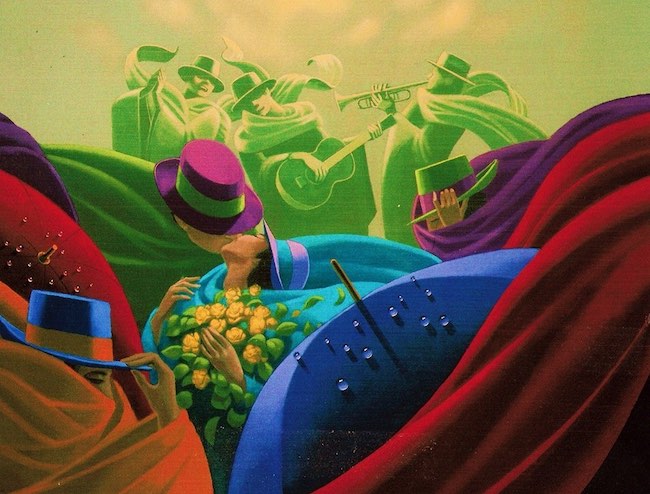L’esistenza contemporanea, la riflessione profonda sulle difficoltà e le sofferenze a cui l’anima è spesso sottoposta, spinge la ricerca artistica verso l’esplorazione di tutto ciò che in qualche modo va a interagire in maniera a volte impattante altre sopraffacente sulla delicata interiorità dei creativi, di quel mondo sensibile che trova il canale comunicativo attraverso l’espressione figurativa. Questa consapevolezza, questa necessità di liberare sensazioni ed emozioni che diversamente non troverebbero la forza di manifestarsi, tende tuttavia ad allontanare dalla possibilità di considerare tutte quelle sensazioni semplici e immediate che invece contribuiscono a rendere la vita un viaggio meraviglioso, piacevole e appagante. L’artista di cui vi racconterò oggi ha dedicato la sua intera produzione pittorica alla narrazione di tutte quelle emozioni positive e immediate in grado di dare un punto di vista diverso e meno complesso su tutto ciò che appartiene all’esistenza.
A partire dalla fine dell’Ottocento vi furono alcuni rappresentanti dei principali movimenti pittorici dell’epoca che si distinsero per un approccio positivo alla vita, visibile nella loro espressione artistica, in alcuni casi persino distaccandosi dalle interpretazioni dei loro colleghi; l’Impressionismo aprì le porte alla piacevolezza del vivere, raccontò i momenti di svago della borghesia emergente rivelandosi come una celebrazione di tutte quelle sensazioni considerate quasi superficiali perché orientate a mettere in risalto il lato bello, la spensieratezza, l’amore per la vita all’aria aperta, concetti che fino a poco prima erano completamente esclusi dalla narrazione artistica. Le leggiadre ballerine di Edgar Degas, le atmosfere idilliache degli scorci di vita sociale di Pierre-Auguste Renoir e di Édouard Manet lasciano nell’osservatore un senso di leggerezza necessario a generare una sensazione di evasione dalle complicazioni del vivere quotidiano che in qualche modo rigenera l’anima. Poco dopo nell’Espressionismo, anticipato dalla breve esperienza sperimentale dei Fauves, alcuni maestri piuttosto che tendere alla manifestazione delle inquietudini e delle sofferenze del vivere, preferirono raccontare la bellezza delle piccole cose, il privilegio di poter condurre un’esistenza appagante in virtù della capacità di considerare non ciò che manca o che si potrebbe raggiungere piuttosto di esaltare ciò che ne fa già parte. Marc Chagall fu uno dei maggiori rappresentanti di questo modo di interpretare la vita, un sognatore che non poteva non far emergere la sua natura nelle sue opere che hanno lasciato una traccia profonda nella storia dell’arte moderna proprio grazie a quella leggerezza poetica in grado di conquistare grandi e bambini. E poi vi furono gli outsider, quegli equilibristi passati da uno stile all’altro per indole sperimentatrice e anche per esplorare le modificazioni del proprio pensiero e del proprio modo di intendere l’esistenza, come Henri Matisse che da un inizio Naïf ha successivamente abbracciato le linee guida Fauves per poi spostarsi verso un Espressionismo che interagiva con una stilizzazione tendente, verso il suo ultimo periodo, all’Astrattismo. Ciò che non cambiò mai fu la sua capacità di assaporare e gioire dei gesti quotidiani, della rassicurazione delle piccole cose che contraddistinse tutta la sua produzione pittorica. L’artista canadese Claude Théberge, scomparso nel 2008, entra di diritto nelle fila dei positivi, degli artisti della felicità per cui essa non è più una chimera imprendibile bensì qualcosa di tangibile se solo si è capaci di interpretare correttamente la realtà in cui si vive; è questo il messaggio che emerge dalle opere affascinanti e coinvolgenti di cui sono protagonisti ombrelli, fiori, cappelli e sciarpe, come a sottolineare la sofficità di un mondo leggero, che non significa superficiale, e orientato ad assaporare ogni istante di gioia che di volta in volta sopraggiunge.

Laureato all’École des Beaux Arts del Quebec ha spesso viaggiato tra la Francia e il Canada, arricchendo la sua cultura e preparazione pittorica e riuscendo a far conoscere il singolare stile artistico che lo ha reso fin da subito immediatamente riconoscibile grazie al quale ha vinto molti premi ed è tutt’oggi collezionato in tutto il mondo. L’ispirazione per il suo universo di ombrelli e di variopinti cappelli è sempre stata la città di Montréal in cui si ha l’abitudine di aprire gli ombrelloni per le vie della città quando piove, ed è stata questa a diventare una delle caratteristiche di riconoscibilità della sua produzione; non solo, anche le sciarpe lunghe e avvolgenti, la morbidezza degli abiti dei protagonisti, spesso innamorati stretti in un abbraccio, gli strumenti musicali a volte presenti, tutto contribuisce a propagare quella poesia romantica che è parte integrante delle tele di Claude Théberge.
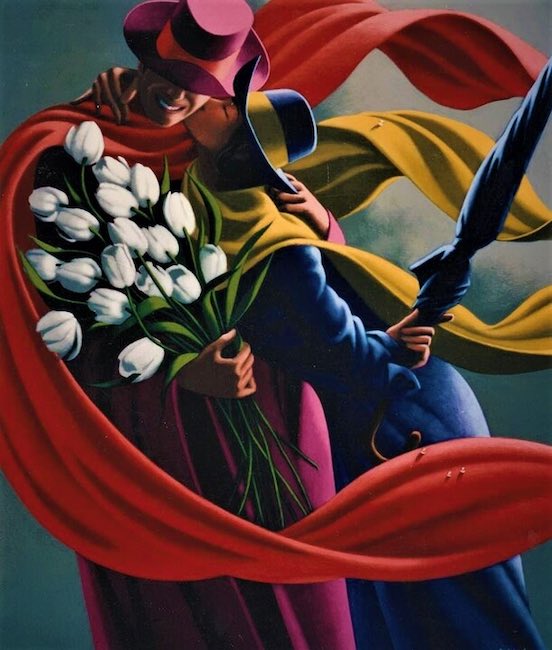
La gamma cromatica è fortemente espressionista perché le tonalità devono accordarsi con l’interiorità, come a richiamare l’attenzione sulla purezza dei sentimenti di cui l’artista racconta, quell’immediatezza emozionale che non può essere filtrata con un’aderenza troppo fedele alla realtà la quale attiverebbe la parte razionale distogliendo l’attenzione dal sentire. La sinuosità delle figure contribuisce a infondere il senso di morbidezza che dovrebbe appartenere all’individuo che vuole davvero assaporare il bello del vivere.
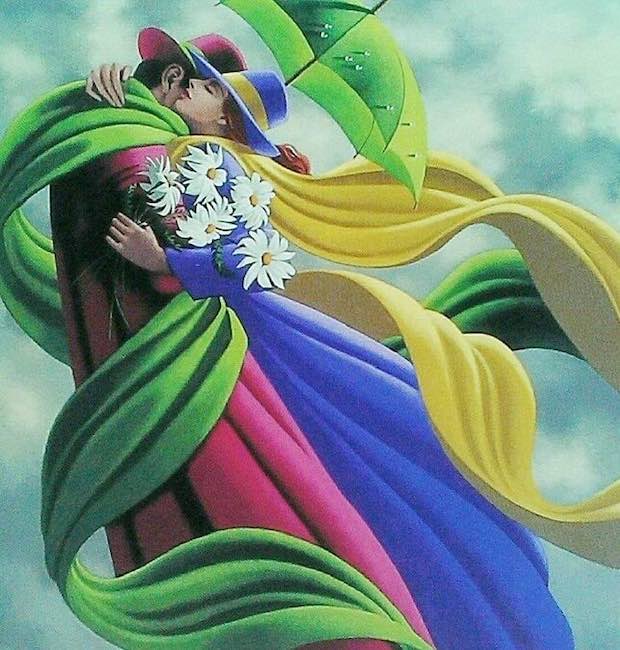
La tela Indian summer racconta di un frammento di emozione, di un incontro forse preceduto da una lunga attesa rendendo il momento del rivedersi un episodio incredibilmente appassionante, tanto quanto intenso è l’abbraccio dei due protagonisti; non manca mai il gesto romantico nelle opere di Claude Théberge, quella galanteria d’altri tempi che però continua ancora a conquistare e ad affascinare l’animo dell’osservatore il quale in qualche modo si perde all’interno della piacevolezza delle atmosfere dell’artista. La gamma cromatica è vivace e sembra stagliarsi sullo sfondo sfumato, tenue, necessario a sottolineare l’armonia di quell’istante magico sospeso nella dimensione dell’amore.
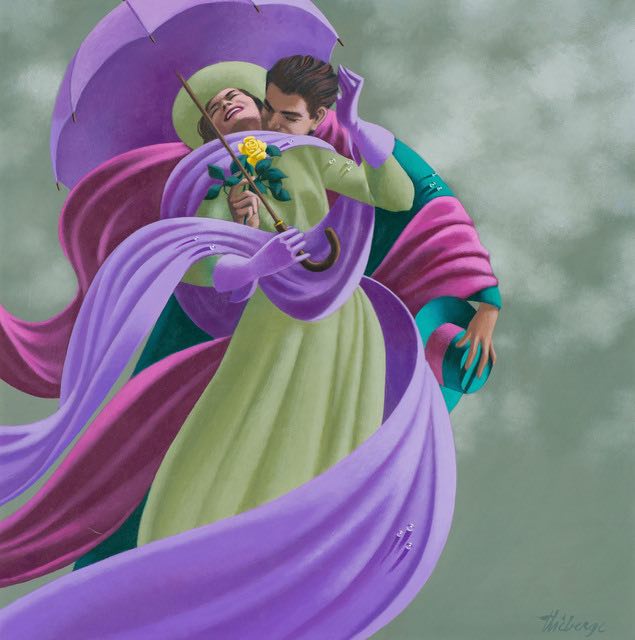
In Le galant homme è presente uno dei temi più cari all’artista, quello dell’ombrello che in questo caso diviene pretesto per l’uomo di poter sorprendere alle spalle la sua donna offrendole una rosa, un gesto gentile che rivela rispetto, premura, riguardo, tenerezza, tutte emozioni che si sprigionano da quell’azione semplice e che Théberge esprime con l’abituale sofficità che contraddistingue la sua intera produzione artistica; la donna è piacevolmente colpita e non riesce a trattenere quel sorriso che l’uomo intendeva strapparle solo per renderla felice attraverso la naturalezza di un’attenzione che non perderà mai il suo valore, al di là del passare degli anni e del cambiamento della società. Un altro tra i temi più ricorrenti della pittura di Claude Théberge è la musica, che accompagna l’esistenza armonizzandosi con le emozioni degli individui e anche con lo sguardo lirico con cui l’artista osserva la quotidianità intorno a sé, quasi come se fosse proprio in virtù della magia generata dalle note musicali che essa riesce a implementare quella connessione tra le persone in grado di trasformare l’esistenza, così come gli incontri, in un bellissimo viaggio pieno di opportunità.
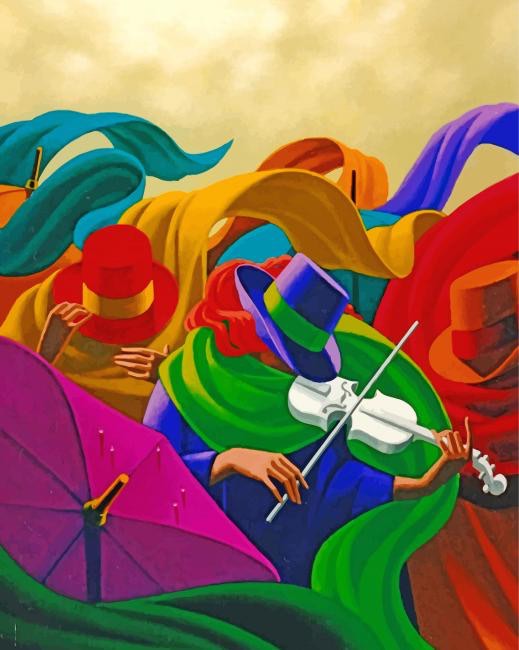
Questo è il senso di La musicienne, opera in cui la violinista sembra essere catalizzatrice di chiunque ruoti nella sua sfera d’azione, allo stesso modo di come un artista di strada riesce ad attrarre magneticamente, con le note dei suoi strumenti, un rapito pubblico sensibile alla bellezza e alla sorpresa di ascoltare musica dove non se la aspetterebbe. I cappelli, le sciarpe, gli ombrelli necessari a ripararsi dalla pioggia, nascondono i volti ma non il calore dell’alchimia generata dalle eleganti e raffinate melodie del violino.
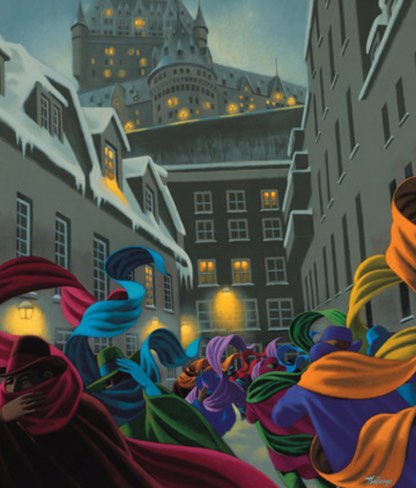
La tela Winter in Quebec è dedicata al suo paese natale, quel luogo dell’anima che l’artista non ha mai definitivamente lasciato, malgrado i continui spostamenti per esporre le sue opere in tutto il mondo, e a dispetto dei numerosi riconoscimenti ricevuti in Francia; l’inverno è la stagione più lunga in Canada, ed è quella che contraddistingue i suoi paesaggi piovosi, in questo dipinto caratterizzato dal vento che sembra scomporre le sciarpe e i cappotti delle persone narrate, abituate al clima poco clemente e proprio per questo raffigurate con colori vivi, intensi, necessari a rompere il grigio dei palazzi dietro di loro.
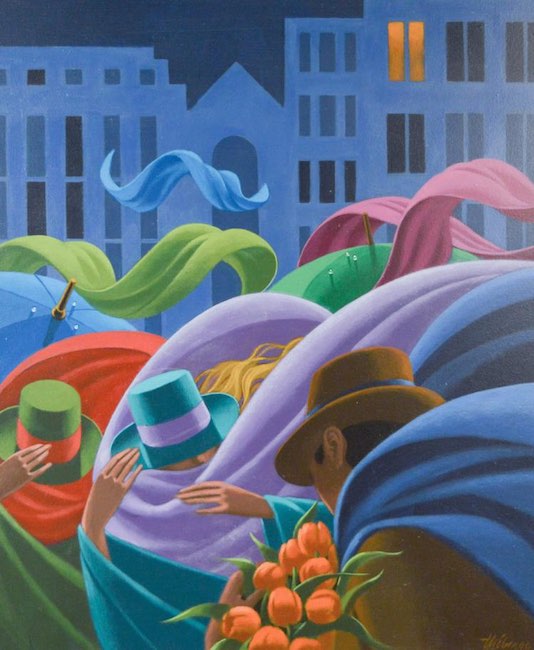
Uno stile inconfondibile quello di Claude Théberge, una capacità figurativa in grado di avvolgere letteralmente l’osservatore trascinandolo in quel poetico e romantico mondo dentro cui lui ha amato perdersi per tutta la sua vita. Le opere di Claude Théberge fanno parte di prestigiose collezioni tra cui l’Aérospatiale in Francia, L’Oréal Lancôme, il Museo di arte contemporanea di Montreal, il Royal British Columbia Museum, il Toronto World Trade Center, la Kennedy Collection in USA. Nel corso degli anni ha partecipato ad eventi artistici tenuti a Parigi, Londra, Copenaghen, Berlino, Madrid, Mosca, Tokyo, New York, Chicago, solo per citarne alcuni.
CLAUDE THÉBERGE-CONTATTI
Email: ctheberge@claudetheberge.com
Sito web: https://claudetheberge.com/
Facebook: https://www.facebook.com/ClaudeThebergeOfficial/
The Romantic Expressionism of Claude Théberge, exploring the pleasantness of life
Contemporary existence, the profound reflection on the difficulties and sufferings to which the soul is often subjected, pushes artistic research towards the exploration of everything that somehow interacts in a way that is sometimes impactful and sometimes overwhelming on the delicate interiority of the creative, of that sensitive world that finds its communication channel through figurative expression. This awareness, this need to liberate sensations and emotions that otherwise would not find the strength to manifest themselves, tends, however, to distance from the possibility of considering all those simple and immediate sensations that instead contribute to making life a marvellous, pleasant and fulfilling journey. The artist I will tell you about today dedicated his entire pictorial production to the narration of all those positive and immediate emotions capable of giving a different and less complex point of view on everything that belongs to existence.
From the end of the 19th century onwards, there were some representatives of the major painting movements of the time who distinguished themselves through a positive approach to life, visible in their artistic expression, in some cases even distancing themselves from the interpretations of their colleagues; Impressionism opened the door to the pleasantness of life, recounted the leisure moments of the emerging bourgeoisie, revealing itself as a celebration of all those sensations considered almost superficial because they were oriented towards emphasising the beautiful, the carefree, the love of life in the open air, concepts that until recently had been completely excluded from artistic narrative. The graceful dancers of Edgar Degas, the idyllic atmospheres of Pierre-Auguste Renoir‘s and Édouard Manet‘s glimpses of social life leave the observer with a sense of lightness necessary to generate a feeling of escape from the complications of everyday life that somehow regenerates the soul. Shortly afterwards in Expressionism, anticipated by the short-lived experimental experience of the Fauves, some masters, rather than tending towards the manifestation of the anxieties and sufferings of living, preferred to recount the beauty of small things, the privilege of being able to lead a fulfilling existence by virtue of the ability to consider not what is lacking or what could be achieved rather than to exalt what is already part of it.
Marc Chagall was one of the greatest representatives of this way of interpreting life, a dreamer who could not fail to bring out his nature in his artworks, which have left a deep mark on the history of modern art precisely because of that poetic lightness capable of winning over adults and children alike. And then there were the outsiders, those equilibrists who passed from one style to another out of an experimental nature and also to explore the modifications of their own thought and way of understanding existence, like Henri Matisse who from an initial Naïve style later embraced the Fauves guidelines and then moved towards an Expressionism that interacted with a stylisation tending, in his last period, towards Abstractionism. What never changed was his ability to savour and rejoice in everyday gestures, in the reassurance of small things that characterised his entire pictorial production. The Canadian artist Claude Théberge, who passed away in 2008, joins the rank of positive artists for whom happiness is no longer an unattainable chimera but something tangible if one is only capable of correctly interpreting the reality in which one lives. This is the message that emerges from his fascinating and captivating artworks featuring umbrellas, flowers, hats and scarves, as if to emphasise the softness of a light world, which does not mean superficial, and oriented towards savouring every moment of joy that comes along. A graduate of the École des Beaux Arts in Quebec, he has often travelled between France and Canada, enriching his culture and pictorial training and succeeding in making known the unique artistic style that made him immediately recognisable, thanks to which he has won many prizes and is still collected all over the world. The inspiration for his universe of umbrellas and multicoloured hats has always been the city of Montréal where people have the habit of opening umbrellas in the streets of the city when it rains, and this has become one of the recognisable features of his production; not only this, but also the long, wrap-around scarves, the softness of the protagonists’ clothes, often lovers clasped in an embrace, the musical instruments that are sometimes present, all contribute to propagating that romantic poetry that is an integral part of Claude Théberge‘s paintings.
The chromatic range is strongly expressionist because the tones must be in tune with interiority, as if to draw attention to the purity of the feelings of which the artist speaks, that emotional immediacy that cannot be filtered with an adherence too faithful to reality which would activate the rational side by distracting attention from feeling. The sinuosity of the figures contributes to instilling the sense of softness that should belong to the individual who really wants to savour the beauty of living. The canvas Indian summer tells of a fragment of emotion, of a meeting perhaps preceded by a long wait, making the moment of seeing each other again an incredibly exciting episode, as intense as the embrace of the two protagonists; the romantic gesture is never lacking in Claude Théberge‘s artworks, that old-fashioned gallantry that still continues to conquer and fascinate the soul of the observer who somehow loses himself within the pleasantness of the artist’s atmospheres. The colour palette is lively and seems to stand out against the soft, muted background necessary to emphasise the harmony of that magical instant suspended in the dimension of love. In Le galant homme is present one of the artist’s favourite themes, that of the umbrella, which in this case becomes a pretext for the man to surprise his woman behind her back by offering her a rose, a gentle gesture that reveals respect, care, tenderness, all emotions that emanate from that simple action and which Théberge expresses with the usual softness that distinguishes his entire artistic production; the woman is pleasantly struck and cannot hold back that smile that the man intended to wring from her only to make her happy through the naturalness of an attention that will never lose its value, beyond the passing of the years and the changes in society. Another of the most recurring themes in Claude Théberge‘s painting is music, which accompanies existence by harmonising with the emotions of individuals and also with the lyrical gaze with which the artist observes the everyday life around him, almost as if it were by virtue of the magic generated by musical notes that it succeeds in implementing that connection between people capable of transforming existence, as well as encounters, into a beautiful journey full of opportunities. This is the meaning of La musicienne, a painting in which the violinist seems to be a catalyst for everyone who revolves within her sphere of action, in the same way as a street performer succeeds in magnetically attracting, with the notes of his instruments, a rapt audience sensitive to the beauty and surprise of hearing music where they would not expect it. The hats, the scarves, the umbrellas necessary to shelter from the rain, hide the faces but not the warmth of the alchemy generated by the elegant and refined melodies of the violin. The canvas Winter in Quebec is dedicated to his native country, that place of the soul that the artist has never definitively left, despite his constant travels to exhibit his works all over the world, and despite the numerous awards he has received in France; winter is the longest season in Canada, and it is the one that characterises his rainy landscapes, in this painting marked by the wind that seems to break up the scarves and coats of the people portrayed, accustomed to the less than clement climate and precisely for this reason depicted with vivid, intense colours, necessary to break up the grey of the buildings behind them. Claude Théberge‘s is an unmistakable style, a figurative ability that can literally envelop the observer, drawing him into that poetic and romantic world in which he has loved to lose himself throughout his life. Claude Théberge‘s artworks are part of prestigious collections including the Aérospatiale in France, L’Oréal Lancôme, the Montreal Museum of Contemporary Art, the Royal British Columbia Museum, the Toronto World Trade Center, and the Kennedy Collection in the USA. Over the years, he has participated in art events held in Paris, London, Copenhagen, Berlin, Madrid, Moscow, Tokyo, New York and Chicago, to name but a few.


